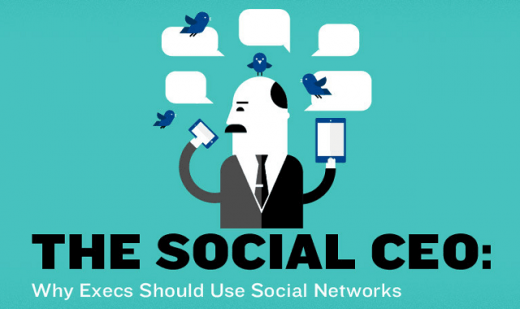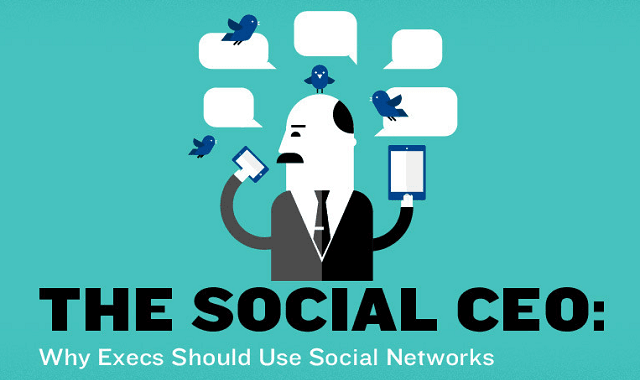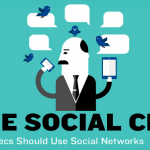The Social CEO in the Age of Trump
— April 3, 2017
Time was a CEO could lead a business fairly quietly, according to his own personal style. As long as he could capably oversee and deliver a successful company performance, there was little pressure to change and become the social CEO. Today, however, a business leader is expected to be a chief communicator, and social media has amplified the opportunities―and the pressure―to speak out.
Social engagement presents a dilemma for CEOs who question the return on the social media investment or worry about its risks. Yet most are increasingly expected to build and grow a presence on Twitter or Medium, to opine on social and even political issues, and to deliver a colorful post or tweet with witty reactions to topical events. After all, it seems that high-profile CEOs are masters of Twitter or LinkedIn, and they relentlessly tout the benefits of having a digital profile. Hootsuite’s CEO Ryan Holmes puts it well. “Social media, used correctly, can be an executive productivity tool, a global broadcast channel, a source of consumer and competitor intel, and a PR vehicle.”
Is the Social CEO More Successful?
But is the social CEO really more successful? Or are the most visible leaders just naturally drawn to social media? Those who push CEOs to be social tend to be―surprise!―PR and digital marketing people or CEOs of social media companies like Holmes. Where’s the evidence that it works to help business?
Take a look at the top 100 CEOs on Twitter. It reads like a who’s who of today’s executive ranks, topped by Richard Branson and including Bill Gates, Arianna Huffington, Elon Musk, and of course, Twitter’s own Jack Dorsey. The chicken-and-egg question remains. Is Marc Benioff really a social media master, or did he simply extend his profile onto social platforms?
Then there’s the risk factor. It hasn’t helped that the President of the United States is so fluent on Twitter, communicating directly to a huge constituency through controversy and chaos and occasionally targeting private citizens and corporations. President Trump’s impulsive tweets have been a red flag to some corporate executives who’d prefer to be above the fray. Maybe it’s part of the reason why only 39% of Fortune 500 CEOs have any social profile whatsoever. And of those who are active on social media, 70% use only LinkedIn.
Yet there is data that bears out the advantages of going beyond LinkedIn and being a social CEO, though the information is subjective. A 2015 Weber Shandwick study of company executives found that those who are active on social media or author content for digital channels are seen as good communicators and are among the most well-regarded among business leaders.
Most PR and reputation experts agree that a strong social profile is an excellent way to differentiate a business leader’s image. It’s also a vehicle to test and refine the kinds of ideas and opinions that inform a thought leadership platform. More practically, it’s efficient communications. A social CEO or key executive can reach journalists, analysts, partners, and employees with a single tweet or Medium post. And social messaging can enhance a company’s overall brand, making it seem more interesting or innovative. It also has a humanizing effect on the brand.
Beyond the most celebrated of social CEOs, I particularly like the example of Lenovo’s Yuanqing Yang, an ardent social media proselytizer who uses Twitter, LinkedIn, and Weibo to build and engage with a global following. Yang didn’t just set the example at Lenovo; he made sure its entire leadership team is active on at least one online social media platform.
One reason for developing a social profile that, in my opinion, doesn’t get enough attention is the internal communications factor. A social CEO and top management activity can help with recruiting and internal communications. It’s also not just about broadcasting your views or posting company updates; true social engagement is about interaction. Yang is a LinkedIn influencer, but he makes it a point to interact directly with the public so that his company and its customers can learn from each other.
Six Tips for the Social CEO and C-level Execs
Social media is most valuable to a social CEO or C-level executive as part of an overall communications strategy. Here are some key points to note in planning such a strategy.
Start by listening.
What some people don’t always realize about social platforms like Twitter and LinkedIn is that they can be excellent vehicles for listening to customers and stakeholders. As Hootsuite’s Holmes points out, Twitter is a great source of intelligence―from competitors, analysts, pundits, and others. After weeks of tuning into the relevant conversations around you, it becomes easier and more natural to engage peers and others.
Stick to a social media strategy.
Who are the key audiences that can be reached better or more efficiently through social content? What are your communications priorities? What simple goals (engagement, interaction, reposts) can you revisit to mark progress? A strategy will help keep the social program from becoming a casualty of being overly ambitious. Only 62% of CEOs with a Twitter account are active, according to CEO.com. Maybe they wanted to claim their handle to subvert social hijackers, but it’s not a good look for a CEO to have a dormant Twitter feed.
Consider a C-level blog.
A blog is still a natural hub for a CEO’s voice, and it’s a logical first step in establishing a content program. It’s also a practical way to address part of the problem of what to post/tweet. It offers opportunities to mix it up with guest posts, post video entries or interviews, and use graphics to illustrate insights.
Mix it up.
It pays to mix personal observations and opinions with sharper reflections about business or industry trends. Business travel, sports, family―all can be great social fodder.
Be an advocate.
In my experience, advocacy can help many C-levels overcome reluctance or even shyness. It’s ideal if the platform is business-related―like STEM education for a technology company CEO or a focus on entrepreneurship for a CEO who got his or her start by bootstrapping a business. But it isn’t limited to business; it can be support for a charity or other. The important thing is a genuine connection.
Invite commentary.
Ask questions, use Twitter polls, jump on hashtags (judiciously), and RT or repost the content of other company leaders or customer.
At a recent sales meeting, Lenovo’s Yang summed up the golden rule for mixing promotional social content with non-commercial posts. “I cannot just promote a Lenovo product every day,” he told employees. “I have to get people interested first and then find the opportunity to promote it once in a while.”
Business & Finance Articles on Business 2 Community
(26)














